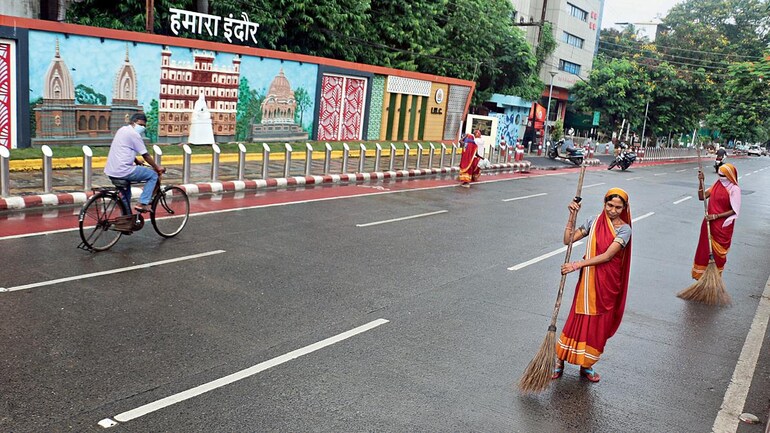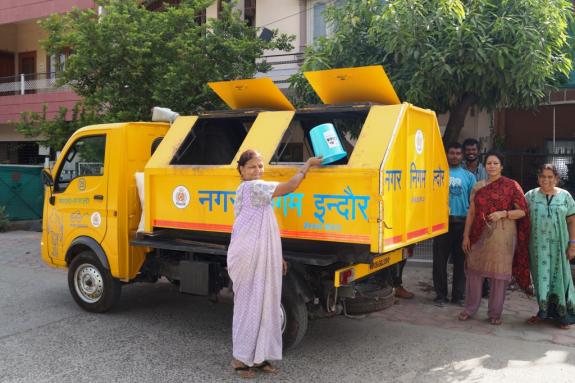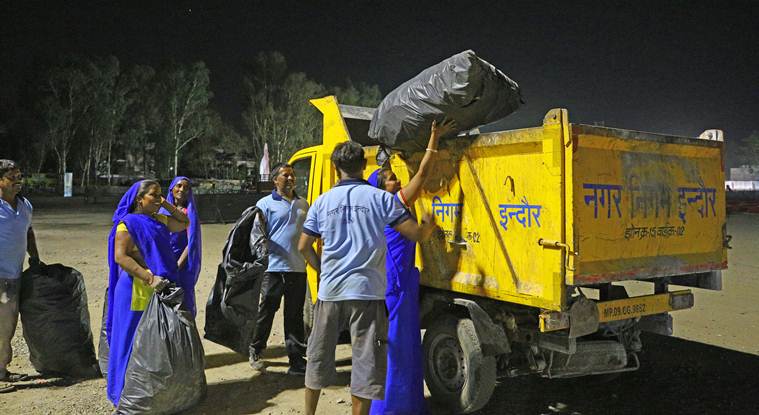Of the 4242 cities surveyed in the 2020 Swachh Survekshan, conducted by the Ministry of Housing and Urban Affairs, Indore emerged as the winner. This came as no surprise since the city has been way ahead of the curve for four years in a row now. As this year’s survey gets underway, Indore is once again poised to be a frontrunner.
But what exactly is the secret to its success? While other cities grapple with their waste management problems, how has Indore cleaned itself up, and maintained the state of affairs since 2017? How has the seemingly small city outwitted other cosmopolitan centers of the country?
A closer examination shows how a robust municipal machinery, community participation and active citizen engagement helped Indore achieve the improbable.

A Messy History
The largest industrial hub in Madhya Pradesh was not always the clean model city it is today. In the early years of Swachh Survekshan, Indore performed poorly, ranking as low as 149th in the list in 2014. Garbage littered the streets, dustbins overflowed, and the city earmarked a large tract of land for waste disposal. With stray animals roaming freely and diseases like malaria and dengue commonplace, Indore was once upon a time a festering garbage dump.
Even if authorities streamlined waste management, the city had inherited 13 lakh tons of legacy waste, with more accumulating each day. The garbage stockpile became a breeding ground for disease causing pathogens and emitted a pungent odor. The decomposition also released methane that induced hazardous fires.
The waste collection apparatus was severely lacking with door-to-door collection limited to only 5 percent. In the absence of an organized management, fecal sludge disposal also continued unchecked
Helpless and fed-up with the situation, residents organized regular protests against the apathetic municipal administration. A social worker filed a PIL in the High Court imploring the municipal corporation to clean up its act.
A New Beginning
But despite these hurdles, Indore underwent a remarkable overhaul. Three years later, in 2017, it made the unbelievable leap to the first spot in the Survekshan rankings. Unlike the conventional top-down administrative approach, the authorities followed a minimal hierarchical plan to ensure waste management. The municipal corporation and an active municipal commissioner, along with environmental NGOs developed a three-pronged strategy.
The primary objective was to render Indore bin-free, dust-free, and litter-free.
This blueprint began with the efforts of an entrepreneur, Asad Warsi, an environmentalist and resident of the city. He prepared a holistic strategy to address the issue. Another prominent individual who jumpstarted the efforts was Indore’s municipal commissioner, IAS officer Asheesh Singh. The commissioner, a proactive officer, was diligently committed to transforming the city into a landfill-free and open-defecation-free (ODF) zone.

- Solid and Wet Waste management: The first step towards addressing the legacy waste crisis began with cleaning up the 100-acre landfill site. The teeming 13 lakh ton garbage at the dumping yard was cleared out within six months at war-footing, without outsourcing the job to contractors. Under Asheesh Singh’s able leadership, Indore employed bio-remediation technique for the legacy waste. Bio-remediation or bio-mining is the eco-friendly process of separating soil and recyclable waste like plastic, cloth, metal, and paper. These recyclables, obtained after bio-remediation, were recycled and used in cement plants, construction materials, and in laying roads.
The processing plants also utilized wet waste by converting it into compost. The authorities used organic waste to produce methane in dedicated Waste-To-Energy plants. Further, these processing units converted the natural biogas to compressed natural gas (CNG). Today, Indore operates about 50 city buses fueled by CNG.
The soil, clear of harmful wastes, was treated with agents to make it suitable for growing plants. The 100-acre reclaimed land has now been transformed into a garden and a 90-acre forest- a remarkable facelift in such a short time span.

- Waste Collection Vans: The corporation began a pilot drive in two wards by replacing cycle rikshaws with Tata Ace vehicles for household waste collection. Each vehicle had the capacity to cover 1000 households a day. It also had different sections for dry and wet waste. Indore invested in 400 GPS-linked vehicles to handle door-to-door collection.
Following its success, the authorities replicated the initiative in other wards and eventually covered the whole city.
- Best Practice Messaging: Next, an awareness campaign began to educate people about waste segregation. Proper domestic waste disposal was crucial. Hence, people were instructed to ensure separation of garbage into dry and wet waste before disposal. Self-help groups trained residents in home-composting, which popularized the idea of converting domestic waste to compost.
Often waste collection vans, fitted with loudspeakers, periodically relayed the significance of waste segregation. Religious leaders joined hands to spread the message. Habitual campaigns like this helped foster responsible disposal practices among citizens.

- Staff Motivation: Another difficult task involved motivating the safai karmacharies and instilling a better work ethic among them. This included introduction of compulsory biometric attendance. Those reluctant to adhere to new guidelines faced suspension and termination. Gradually, the corporation successfully achieved 90 percent cleaning staff attendance.
Those in charge also realized that stringent rules would be difficult to impose over the workforce. So, they adopted a cordial strategy to incorporate disenchanted workers, address their issues and motivate them to perform their duties with commitment.

- Commercial Waste Collection: In commercial areas, waste collection is undertaken twice a day. This step also helped eliminate dustbins from public spaces. As per the guidelines for eateries, restaurants and dhabas must have a dustbin. The municipal body spot-fined violators a minimum of 250 rupees.
Mass mobilization drives, in addition to such strict rules, advanced the objective of better waste management.
- No-Plastic Drive: The stakeholders made recycling plastic waste a priority. The corporation provided each household with two bags to collect their single-use plastic waste. The corporation then purchased the plastic waste from the citizens for 1.5 to 5 rupees a kilogram.
Thus, scrap plastic became a remunerative source for people. It also lowered logistic costs of collection, segregation, and transportation of plastic waste. Besides this, the government opened ‘Bartan Banks‘ in different areas of the city to encourage the use of steel vessels instead of disposable single-use plastic.

- Waste Water Treatment: The administration began cleaning drains and nullahs while also handling solid waste management. The corporation spared no efforts to clean rivers and lakes. Complete sewage treatment ensured the end of industrial or domestic wastewater discharge into the city’s water bodies. The authorities provided a provision to supply treated wastewater for reuse in agriculture and gardening. The city now boasts of a completely covered drainage system and has become eligible for the Water+ certification.
Additionally, the administration set up 10,000 public toilets after identifying 128 OD site to achieve the open-defecation-free status. They installed smart alert systems for timely cleaning of these toilets. The local body took measures to discuss and resolve Community issues and social stigma associated with open defecation. The active participation of residents, keen to clean their city, helped it achieve total ODF status in 2016.
What Indore Teaches Us
Some might simplify the city’s success by attributing its relatively smaller size, rapid urbanization, and existent latrine coverage. Indore however is not just a ‘success island’. The calibrated quantitative and qualitative measures it undertook helped it resolve a burgeoning crisis. Therefore, Indore’s stunning achievement, now heralding similar sanitation measures in other cities, is not a miracle. It is a prominent example of sheer political will, motivated community spirit, and disciplined work ethic culminating in a near-impossible feat. It is all the proof we need to stop pointing fingers at the state of our cities, shoulder civic responsibility, and follow the path of Indore, the trailblazer.

